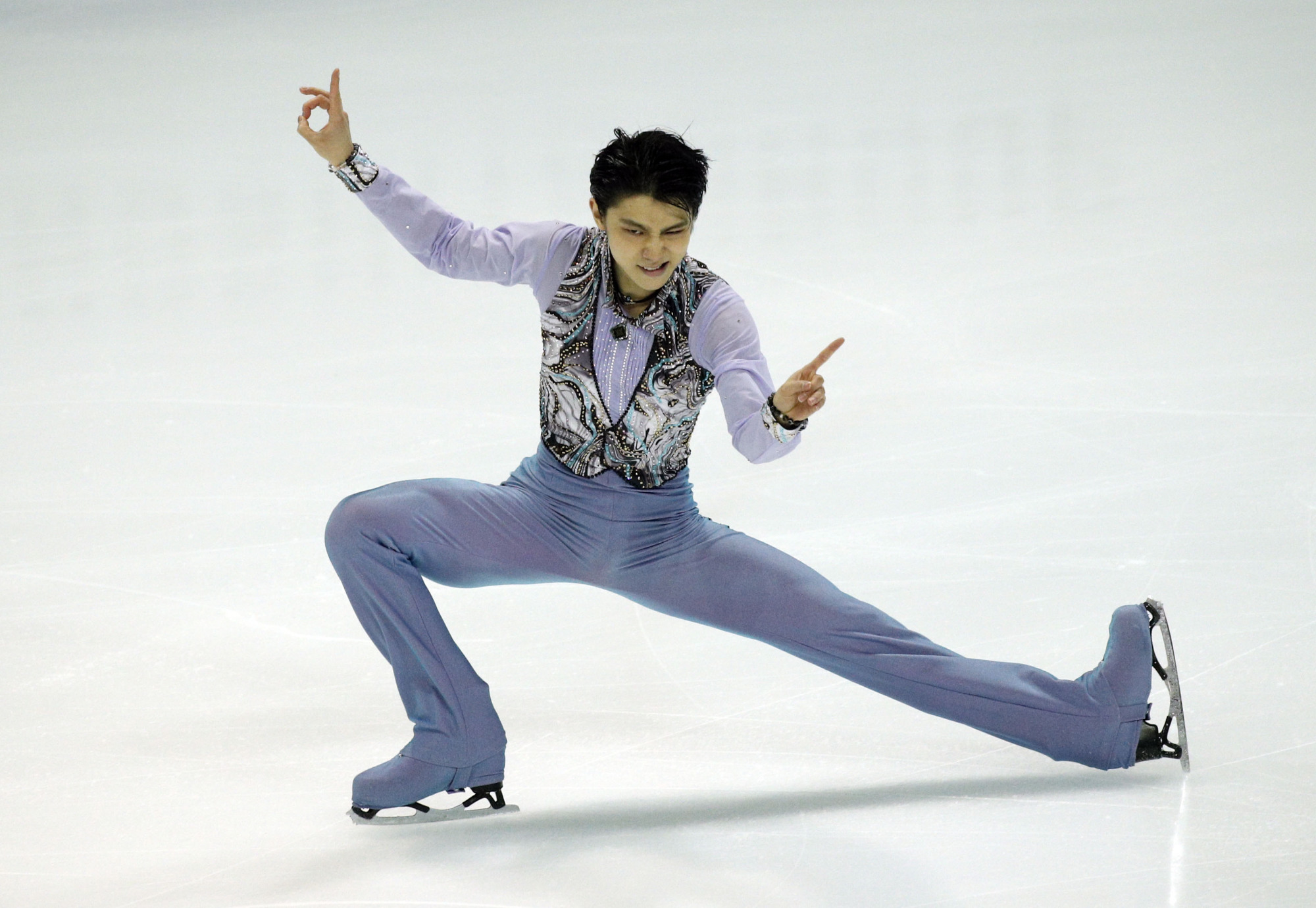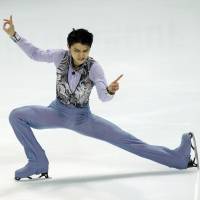Yuzuru Hanyu's victory at the Grand Prix Final in Marseille, France, on Saturday made it five straight years that a Japanese man has won the title at the event.
Daisuke Takahashi began the streak back in 2012, and Hanyu not only kept the run going with his latest triumph, he made more history in the process. This was the 22nd GP Final, and never before had a male or female skater won it four straight times until Hanyu achieved it.
Russian legend Evgeni Plushenko won the GP Final four times, but he did not do it four times in a row. Hanyu, who prevailed with a total score of 293.90, has again established another new standard and an incredible one at that.
The Olympic champion, who turned 22 last week, spotted himself a nice lead with his short program on Thursday to Prince's "Let's Go Crazy" that earned him a score of 106.53. That was the third highest short program score in history.
There is an old adage in skating that says, "You can't win an event in the short program, but you sure can lose it." This is so very true.
Hanyu understands this and it is one of the reasons why he owns the top five short program scores of all time.
The plaudits poured in for Hanyu from the experts on his latest accomplishment.
"That was fantastic," said Eurosport announcer Simon Reed after Hanyu's short program. "For me the greatest male skater I have ever seen."
"He has such flare, control, strength, character ... he is an immense talent," added Eurosport analyst Chris Howarth.
CBC commentator Carol Lane said she thinks Hanyu has the ideal body type for skating.
"There is just something about his physicality that makes him totally suited to do every single thing that this sport requires," noted Lane during Hanyu's free skate. "He's so slender and elegant. He almost has a bird-like structure to me that makes him weightless in the air, or appears to make him weightless in the air."
Lane then pointed out what Ice Time has referred to as Hanyu's "feathery touch" on his landings.
"He's a light jumper and a light lander particularly," Lane stated.
Four-time world champion Kurt Browning, also an analyst for CBC, then said: "That could be handy for longevity in his career."
Hanyu's physique looks almost identical to what it was six years ago when he was the world junior champion. It really is amazing.
Reed commented two weeks ago during the NHK Trophy about Hanyu's strength and I concur. Ice Time estimates that Hanyu's body fat is just 1 or 2 percent. Though he does not appear outwardly muscular, it looks like he has no fat at all.
According to the website livestrong.com, "male athletes typically have a body fat percentage of between 6 and 13 percent." But as we have seen, Hanyu is not typical athlete. The strength needed to generate the speed and lift to do four-revolution jumps continuously has to be incredible.
The Sendai native did struggle in the second half of his free skate in Marseille, falling on his quad salchow/triple toe loop combination jump and singling a triple lutz, but still won in decisive fashion.
Nagano Olympic champion Tara Lipinski, an analyst for NBC, believes that Hanyu's concentration can be an issue at times.
"Sometimes Yuzuru is a wild card," she said while analyzing his free skate. "It confuses me. He is probably one of the best technicians in the world, which you would think 9 out of 10 times he is going to hit his jumps. But sometimes in the free skates he loses his mental stability a little bit and all of sudden makes these messy landings or starts popping or falling and that just should't happen with someone so good."
"I feel very disappointed with my long program but the result is good," the ISU website quoted Hanyu as saying. "Figure skating is the total of the short program and the free program and I think I had a really good short here, so I'm really happy about that and I think this was a good learning experience. I've learned something and gained something and I've got my homework to move on with."
The bottom line is that 14 months out from the Pyeongchang Olympics, Hanyu beat the best skaters in the world without his top performance. He has to be considered the favorite to retain the Olympic gold medal in 2018.
Overshadowed: Nearly lost in the glare of Hanyu's latest triumph was the performance of compatriot Shoma Uno in taking the bronze medal for the second straight year.
Uno was in fourth place after falling on his quad toe loop/triple toe combo in the short program, and with the likes of Hanyu, two-time defending world champion Javier Fernandez and Patrick Chan also entered, Uno's prospects for a medal did not look good.
But the Nagoya native put on a great show in the free skate, landing three quads and nearly claiming the silver medal, finishing less than half a point behind American Nathan Chen (282.85 to 282.51).
NBC analyst Johnny Weir said he wasn't sold on Uno's free skate to "Buenos Aires Hora Cero" when he first saw it, but is now.
"He is so passionate. So intense on the ice, it is perfect for him," stated Weir, after Uno posted a personal best of 195.69.
Lipinski lavished praise on Uno after his stellar free skate.
"He is a brilliant technician, but he is also a gorgeous skater," Lipinski commented. "The smoothness of his steps, he mixes it with this defined sharpness that creates these beautiful images in his choreography. I thought that was fabulous."
"I'm pretty happy with my free program," Uno stated. "I think I skated quite well yet it was not perfect. I am still young and not very experienced, but with every competition and every experience I make there I can learn and get better preparing in between the events."
Ice Time believes that Uno has a great shot at making the podium in Pyeongchang. Uno, who will turn 19 on Saturday, is only going to continue to improve in the coming years.
Sublime: Satoko Miyahara earned the silver medal behind world champion Evgenia Medvedeva on Saturday, marking the second year in a row she has finished second behind the Russian at the GP Final.
Miyahara did it once again with her incredible elegance and presentation, moving up from third after the short program to claim the silver. She landed six triple jumps and notched a personal best of 143.18 in her free skate to "The Planets," under-rotating just a triple flip.
"The flip was not my best, but that was the only not so good part of my program," said Miyahara. "I am happy but I still can do more and better. My feeling was getting higher and higher towards the end of my program."
NBC Universal announcer Tanith White saluted Miyahara's gracefulness and expressed the opinion that the petite 18-year-old has not been scored as fairly some of her competitors.
"She really is an enchanting skater," commented White on Miyahara's short program. "As recent as last season I found her to be consistently undervalued in her component marks. . . . That was such a seamless performance in between the elements. And her stamina is just phenomenal. She's not even out of breath at the end of that program."
Interesting observation: Howarth, who is a former British champion and the skating director at the Glacier Ice Arena in Vernon Hills, Illinois, where Uno occasionally trains, mentioned something interesting during Eurosport's telecast. Howarth talked about how Japanese skaters generally don't use plyometrics in their off-ice training.
What are plyometrics?
They are exercises in which muscles exert maximum force in short intervals of time, with the goal of increasing power (speed and strength). Like jumping from a squatting position up onto a box. They originated in the 1970s with Soviet Olympic athletes and have evolved from there.
With regards to skating, the exercises are believed create more force for jumps. We have heard frequently in the past few seasons about Miyahara's under-rotations and how they have hurt her scores. One wonders if this might not be a possible solution.
Ice Time did some research on the subject and found that in a six-week study of college-age skaters released earlier this year and published in the International Journal of Exercise Science, skaters increased their flight time by 0.029 seconds with plyometrics.
Now that does not sound like a lot, but as the study said, "While this would seem to be a relatively small improvement, an increase of a few hundredths of a second is sufficient time to gain 10 to 20 degrees of rotation, depending on the rotational velocity of the skater. Thus, this small improvement may mean the difference in success or failure when attempting higher revolution jumps."
It was Howarth himself who stated, "It is incredible how fast Satoko rotates," during the GP Final.
Imagine what Miyahara could do with an extra 0.029 seconds of flight time.




